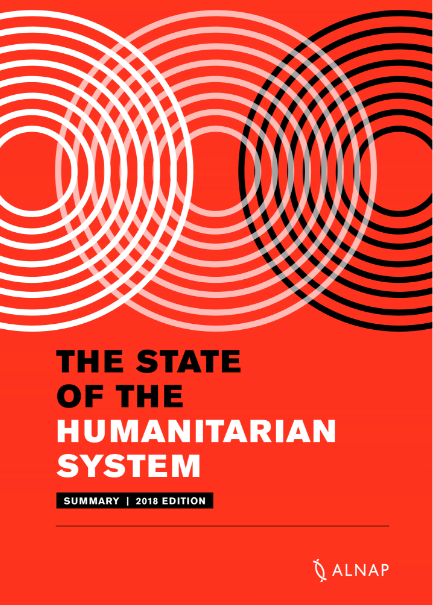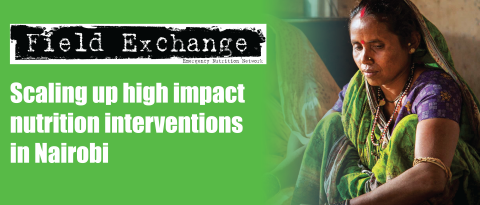The State of the Humanitarian System 2018 report
 The fourth ‘State of the Humanitarian System’ report1, covering the three years from 2015 to 2017, is based on a review of over 200 evaluations of humanitarian action, interviews with over 500 people and case studies from five countries (Bangladesh, Kenya, Lebanon, Mali and Yemen). The report outlines humanitarian needs, provides an overview of humanitarian funding and the current size and structure of the humanitarian system, and presents an assessment of the system’s performance in addressing humanitarian needs. Findings demonstrate that humanitarian needs continued to increase in this period. An estimated 201 million people required international humanitarian assistance in 2017 alone, the highest number to date. The number of people forcibly displaced by conflict and violence also increased, reaching 68.5 million in 2017.
The fourth ‘State of the Humanitarian System’ report1, covering the three years from 2015 to 2017, is based on a review of over 200 evaluations of humanitarian action, interviews with over 500 people and case studies from five countries (Bangladesh, Kenya, Lebanon, Mali and Yemen). The report outlines humanitarian needs, provides an overview of humanitarian funding and the current size and structure of the humanitarian system, and presents an assessment of the system’s performance in addressing humanitarian needs. Findings demonstrate that humanitarian needs continued to increase in this period. An estimated 201 million people required international humanitarian assistance in 2017 alone, the highest number to date. The number of people forcibly displaced by conflict and violence also increased, reaching 68.5 million in 2017.
A small number of complex crises received the majority of funding: half of all international humanitarian assistance went to just four crises (Syria, Yemen, South Sudan and Iraq). There was also a gradual shift in the geographic location of recipients, from sub-Saharan Africa to the Middle East. A small number of donor governments contributed the majority of international humanitarian assistance. Most donor funding went to multilateral agencies, much of which was then passed on as grants to non-governmental organisations (NGOs). Among NGOs, funding was concentrated among large, international organisations; national and local NGOs only received 0.4% of all international humanitarian assistance directly. Money for pooled funds reached a record US$1.3 billion in 2017, 53% higher than in 2014. Cash transfers also grew to an estimated US$.8 billion in 2016, a 40% increase on 2015.
Coverage: Despite increased funding, the humanitarian system still does not have sufficient resources to cover needs due to growing numbers of people in need and potentially also increased ambition on the part of the humanitarian sector. The 2015-2017 period saw a decline in coverage of humanitarian needs, particularly among internally displaced people (IDPs) outside camps; people and communities hosting refugees; people in situations of conflict where access is challenged; and large numbers of irregular migrants.
Appropriateness: Evidence suggests that the humanitarian system’s relevance and appropriateness has improved since 2015. Humanitarian aid comprises a basic package of life-saving assistance, which is seen as relevant in many situations. However, some needs are often not met, including priority protection needs, needs beyond the immediate response ‘package’ and those of the elderly and people with disabilities. There is evidence that multi-purpose cash grants can go some way to increasing the relevance of aid.
Accountability and participation: There has been limited progress in the accountability and participation of the humanitarian system. The main challenge identified in the 2015 report – that existing feedback mechanisms do not influence decision-making – has not been addressed. While there are number of initiatives and approaches that show potential, they have not yet delivered greater accountability or participation. Many interviewees are concerned that accountability to affected populations (AAP) has become a ‘box-ticking exercise’.
Effectiveness: There is evidence of improved effectiveness of the humanitarian system, particularly in terms of meeting immediate life-saving needs in ‘natural’ disasters, responding to sudden movements of refugees and responding to food insecurity in complex emergencies. The system is still not effective in meeting protection needs overall.
Efficiency: There has been limited progress in efficiency, particularly in terms of non-harmonised reporting and ‘pass-through’ arrangements of funding. Increased work on early response has prevented inefficient ‘peak-of-crisis’ responses in some areas and some improvements have been made in joint procurement and supply chains within the United Nations. Increased use of cash has increased efficiency in many areas and there is potential for the ‘Grand Bargain’ process to address several areas related to efficiency.
Coherence: There has been a decline in the level of coherence of the humanitarian system. The increased integration of humanitarian action into development and stabilisation agendas has made coherence with humanitarian principles more difficult for operational agencies. There is also evidence of declining respect for international humanitarian law (IHL) and laws concerning refugee.
Connectedness: There appears to be improved connectedness in the humanitarian system, facilitated by changes in policy and increased funding, which has led to closer connections between humanitarian and development activities, often in the form of ‘resilience’ work. There is some evidence that this has been effective at protecting against future shocks where the work has been done with governments, and where it addresses foreseeable ‘natural’ disasters, but less evidence in other circumstances. Donors are increasingly interested in fragile and refugee-hosting states, ‘peace-building’ initiatives, and in developing financing in countries experiencing conflict and refugee situations.
Complementarity: There is improved complementarity in the humanitarian system. Relations with the governments of crisis-affected states are improving in many cases, although there is still a tendency to push governments aside in rapid-onset, ‘surge’ situations. Relations with governments are often more difficult where the state is a party to internal armed conflict in refugee contexts. There has been significant activity at policy level in strengthening the role of national and local NGOs in the international humanitarian system but, to date, this has had limited effect on the ground.
Impact: There is little hard data measuring the impact of humanitarian responses on wide populations or across time. Very few evaluations attempt to assess impact; in part because the short funding cycles of humanitarian action prevent consistent longitudinal research. There is also a lack of baseline data against which to measure progress. Overall, information on impact is scattered and largely anecdotal and does not allow any overall conclusion to be drawn.
The summary and full reports can be accessed here.
Endnote
1The State of the Humanitarian System is an independent study that compiles the latest statistics on the size, shape and scope of the humanitarian system and assesses overall performance and progress. Published every three years, it provides a sector-level mapping and assessment of international humanitarian assistance.


